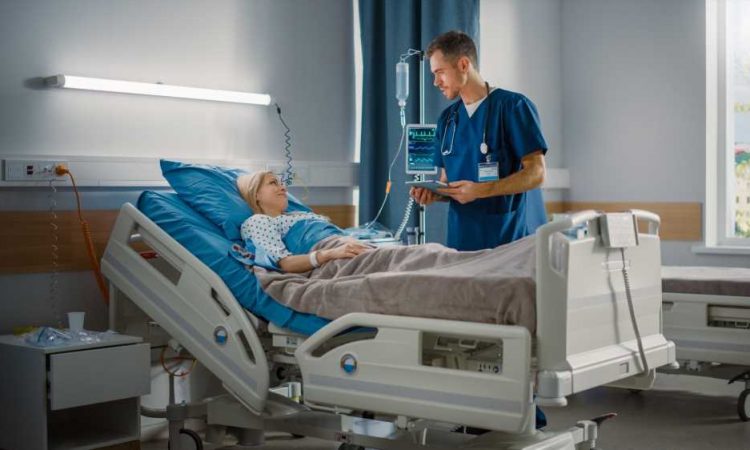The transmission dynamics of SARS-CoV-2 among healthcare workers

In a recent study in Nature, researchers investigate the transmission of the severe acute respiratory syndrome coronavirus 2 (SARS-CoV-2) in hospitals and its impact on the dynamics of the coronavirus disease 2019 (COVID-19) pandemic.
 Study: The burden and dynamics of hospital-acquired SARS-CoV-2 in England. Image Credit: Gorodenkoff / Shutterstock.com
Study: The burden and dynamics of hospital-acquired SARS-CoV-2 in England. Image Credit: Gorodenkoff / Shutterstock.com
Background
Hospital transmission of SARS-CoV-2 is a major concern in healthcare settings, as it increases the risk of poor outcomes for healthcare workers (HCWs) and vulnerable individuals. Non-pharmaceutical interventions (NPIs) have little effect on transmission rates between sick patients and healthcare personnel in hospitals. Thus, it is critical to understand and address knowledge gaps to avoid additional transmission and enhance patient care.
About the study
The researchers quantified within-hospital transmission, evaluated likely pathways of viral transmission and factors associated with heightened transmission risk, and investigated the wider dynamical consequences using information provided by 145 National Health Service (NHS) hospital trusts providing acute care in England, excluding those providing exclusively pediatric care. The trusts included 356 hospitals with a total capacity of 100,000 beds and 859,000 HCWs in full-time jobs.
On March 20, 2020, all trusts completed daily status reports concerning COVID-19 incidence and prevalence, COVID-19-related hospitalizations, and staff absenteeism due to COVID-19. On June 5, 2020, the probable source of COVID-19 was identified based on the durations between hospitalizations and onset of polymerase chain reaction (PCR)-verified COVID-19 among hospitalized individuals, following the European Center for Disease Prevention and Control (ECDC) guidelines.
Infections with a duration of two days or less were categorized as community-onset COVID-19, whereas infections with a duration of three to seven days were categorized as indeterminate healthcare-related. Infections with a duration of eight to 14 days were categorized as likely healthcare-related and those with durations of 15 days or more were categorized as definitely healthcare-related.
The data, collectively with other datasets of national-level information, were used to estimate nosocomial COVID-19 case counts in England between June 2020 to February 2021, nosocomial SARS-CoV-2 transmission routes, and variables influencing the transmission. The researchers investigated the influence of nosocomial COVID-19 on the efficacy of community-level lockdowns in preventing infections by modeling community and hospital dynamics.
Study findings
The time series data analysis demonstrated that patients who contracted SARS-CoV-2 in the hospital were the primary sources of transmission to other patients. Increased transmission to inpatients was related to fewer single rooms and a lower heated volume per bed in hospitals. Thus, reduced hospital transmission might improve the efficacy of future lockdowns in decreasing community transmission.
Between June 10, 2020, and February 17, 2021, there were 19,355 probable and 16,950 definitely healthcare-related COVID-19 cases among hospital inpatients. The authors calculated that a strategy of PCR testing of individuals with COVID-19 symptoms would identify 26% and 12% of nosocomial and nosocomial infections, respectively, satisfying the criteria for definitely healthcare-related infections using empirical values for hospitalization duration.
Additional PCR testing for asymptomatic individuals on hospitalization days three and six raised the proportion found to 33% but did not significantly change the percentage of definitely healthcare-related infections. The incorporation of PCR testing for all COVID-19 patients at one-week intervals to symptomatic PCR tests increased the percentage of diagnosed nosocomial infections to 44% and definitely healthcare-related infections to 17%.
The poor identification and classification probability of definitely healthcare-related infections were due to short hospitalization durations and low sensitivity rates of PCR testing in the initial days of SARS-CoV-2 infection. The upper range for the mean estimate of nosocomial infections was 143,000, whereas the lower range was 99,000. There were nine million hospitalizations over this period, thus indicating that one to two percent of hospitalized individuals had nosocomial COVID-19.
The cumulative rates of hospital-associated infections varied greatly amongst trusts, with the highest rates in the Northwest NHS area and lowest in the Southwest and London regions. Community transmission rates were similar in situations of high hospital transmission, which corresponded to self-sustaining within-hospital transmission, as well as intermediate and low hospital transmission, which lowered all hospital transmission rates by 25% and 50%, respectively.
Conclusions
Hospital-acquired infections are aa serious concern in healthcare settings, with one to two percent of hospital admissions in England likely to contract SARS-CoV-2 infection during the "second wave." HCW immunization has been linked to considerable reductions in infection rates, in addition to certain hospital designs that can influence SARS-CoV-2 transmission.
Asymptomatic screening at a high frequency, combined with the rapid isolation of suspected SARS-CoV-2 patients, can significantly limit viral transmission. The study findings underscore the importance of early identification of COVID-19, mitigation measures for incident nosocomial infections, and prioritizing HCW vaccination for direct and indirect protection against SARS-CoV-2.
- Cooper, B. S., Evans, S., Jafari, Y., et al. (2023). The burden and dynamics of hospital-acquired SARS-CoV-2 in England. Nature. doi:10.1038/s41586-023-06634-z
Posted in: Medical Science News | Medical Research News | Medical Condition News | Disease/Infection News | Healthcare News
Tags: Coronavirus, Coronavirus Disease COVID-19, covid-19, Efficacy, Frequency, Healthcare, Hospital, Immunization, Pandemic, Polymerase, Polymerase Chain Reaction, Respiratory, SARS, SARS-CoV-2, Severe Acute Respiratory, Severe Acute Respiratory Syndrome, Syndrome

Written by
Pooja Toshniwal Paharia
Dr. based clinical-radiological diagnosis and management of oral lesions and conditions and associated maxillofacial disorders.